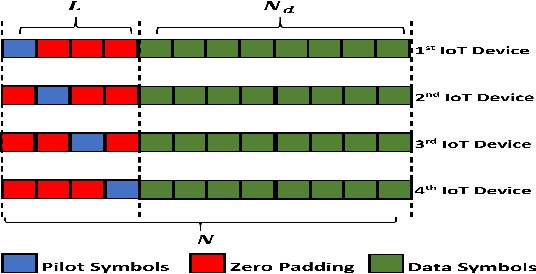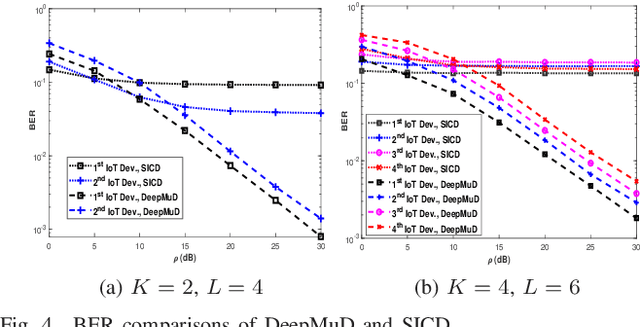Ahmet Emir
DeepMuD: Multi-user Detection for Uplink Grant-Free NOMA IoT Networks via Deep Learning
Feb 18, 2021



Abstract:In this letter, we propose a deep learning-aided multi-user detection (DeepMuD) in uplink non-orthogonal multiple access (NOMA) to empower the massive machine-type communication where an offline-trained Long Short-Term Memory (LSTM)-based network is used for multi-user detection. In the proposed DeepMuD, a perfect channel state information (CSI) is also not required since it is able to perform a joint channel estimation and multi-user detection with the pilot responses, where the pilot-to-frame ratio is very low. The proposed DeepMuD improves the error performance of the uplink NOMA significantly and outperforms the conventional detectors (even with perfect CSI). Moreover, this gain becomes superb with the increase in the number of Internet of Things (IoT) devices. Furthermore, the proposed DeepMuD has a flexible detection and regardless of the number of IoT devices, the multi-user detection can be performed. Thus, an arbitrary number of IoT devices can be served without a signaling overhead, which enables the grant-free communication.
Pilot Interval Reduction by Deep Learning Based Detectors in Uplink NOMA
Apr 26, 2020Abstract:Non-Orthogonal Multiple Access (NOMA) has higher spectral efficiency than orthogonal multiple access (OMA) techniques. In uplink communication systems that the channel is not known at the receiver, pilot signals sent from each user in different time intervals have reduced the spectral efficiency of NOMA. In this study, in the uplink communication system, DL-deep learning based detectors which are known to respond to the pilot signals sent from the users at the base station have been researched. It is aimed to maintain the spectral efficiency of NOMA by sending a single pilot from users, thus reducing the time interval in the DL detectors.
 Add to Chrome
Add to Chrome Add to Firefox
Add to Firefox Add to Edge
Add to Edge